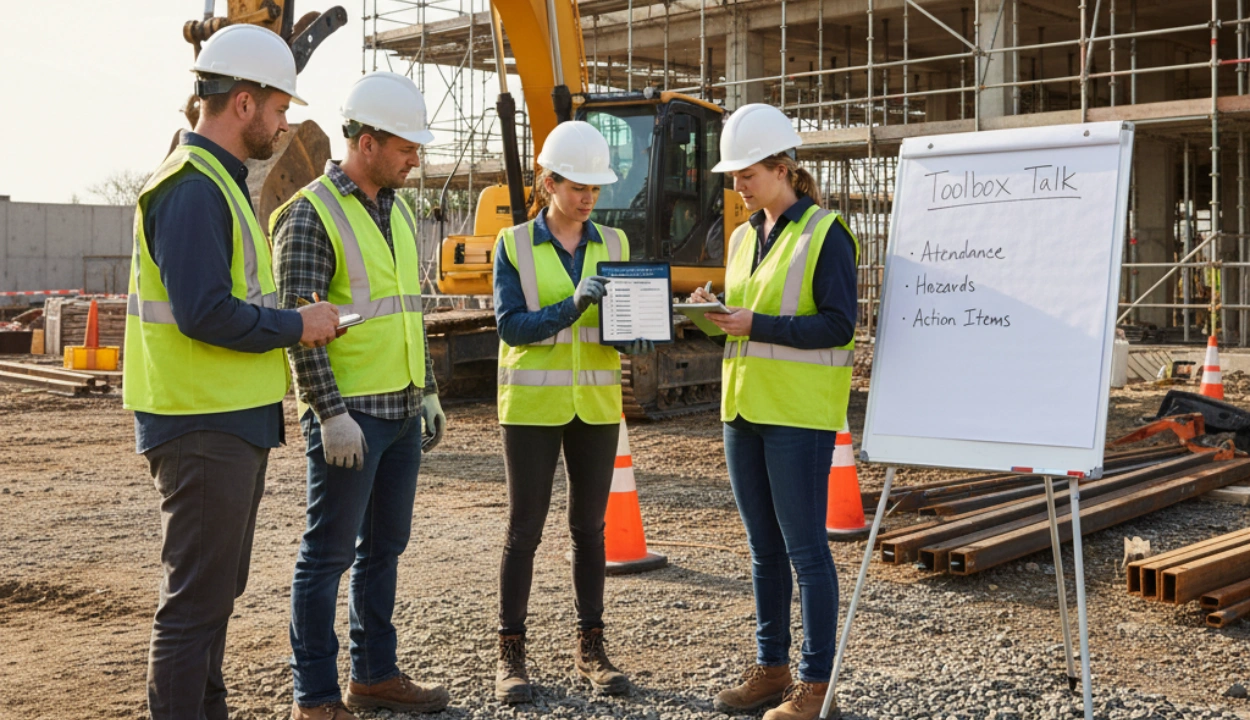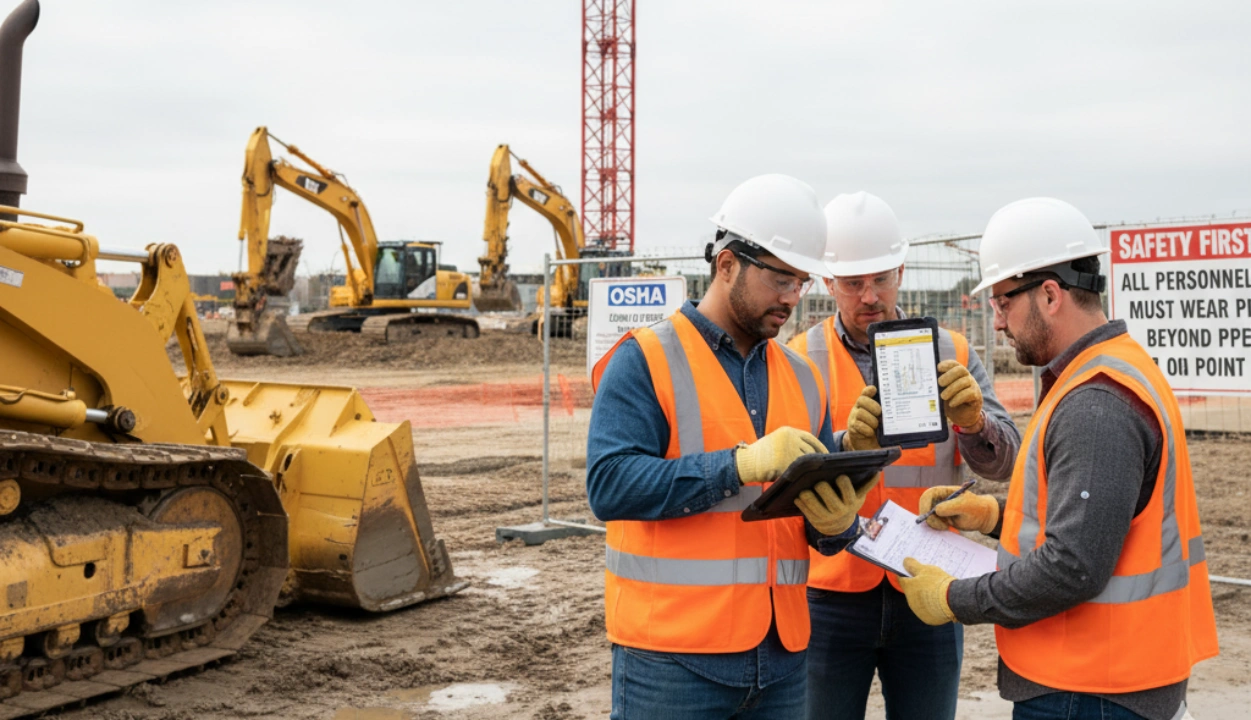10 Tips for Managing Health & Safety in Construction
Due to the constant activity on construction sites, potential dangers are always present.
Adhering to strict health and safety measures is essential for managing health and safety in construction.
Implementing impactful measures can significantly reduce accidents and create a more productive work environment.
This guide offers ten practical tips for managing health and safety in the construction field.
When prioritized, these tips can enhance worker safety and enhance overall project performance.
1. Commit to a Safety Program
Committing to a comprehensive safety program is essential for useful health and safety management in construction.
It establishes clear protocols, reduces risks, and ensures compliance.
By implementing regular safety audits and training sessions, construction companies can significantly lower accident rates and improve overall project safety.
A well-structured program establishes a solid foundation for successful health and safety management in construction.
Ultimately, it protects workers and maintains operational swiftness.

2. Engage and Involve Workers
Engaging workers in safety initiatives offers numerous benefits to enhance the effectiveness of safety programs and improve workplace safety and health on construction sites.
When workers actively participate and provide input, they help identify potential hazards and develop practical solutions.
For example, weekly safety meetings allow workers to share first-hand insights on risks and preventive strategies, leading to more detailed safety plans.
Here are a few significant benefits of involving workers in creating a successful safety plan:
- Improved Safety: Workers, being on the job site daily, are better equipped to identify ongoing hazards that need immediate attention, thereby enhancing safety.
- Increased Compliance: Active involvement ensures that workers understand and adhere to safety protocols.
- Raised Morale: When workers feel valued and empowered, their overall job satisfaction increases.
3. Conduct Regular Risk Assessment
Companies need to conduct regular risk assessments to streamline the process of managing health and safety in construction proficiently.
For example, improper handling and storage of hazardous materials can lead to spills, fires, or exposure to toxic substances, endangering workers' health and safety.
Systematic data collection, such as construction inspection reports and quality control records, helps uncover these issues early.
Work-related fatal injuries in the U.S. construction industry increased to 1,092 cases in 2022 alone, indicating that proper risk assessment is necessary.
Clue, a robust construction equipment management software, is designed to simplify this process.
As an all-in-one solution, Clue handles everything from tracking and maintenance to dispatch and scheduling.
By ensuring regular maintenance and proper usage of equipment, Clue helps prevent equipment failures and accidents.
With fast deployment and integration with existing telematics and major construction software, Clue ensures real-time asset tracking, enhancing overall safety on construction sites.
Ease up your asset management with advanced technology, making it simpler than ever to organize and track your assets.
Easily categorize and search for items to enhance your workflow.
4. Provide Ongoing Training and Education
Ongoing education and training is another vital aspect of managing health and safety in the construction industry.
With 45% of construction companies turning down projects in 2021 due to skilled labor shortages, investing resources in ongoing training became significantly more crucial.
Employees can stay well-informed when they are updated frequently about hazards, safety measures, and emergency health and safety procedures in construction.
Consider a construction site where new equipment is introduced. Workers must be trained on the specific safety procedures for this equipment to prevent accidents.
This ongoing learning process ensures that employees adhere to safety standards and actively contribute to enhancing the overall safety program.
There are many online resources like OSHA featuring 40 construction safety training courses for construction workers and contractors.
5. Implement a Hazard Control Plan
Implementing an efficient hazard control plan and meeting health and safety requirements in construction starts by identifying and reviewing major control options from sources like OSHA standards and industry publications.
Take a workplace with high noise levels. First, engineering controls like soundproofing should be considered to reduce noise at the source.
Next, temporary solutions, such as rotating work shifts to reduce exposure, should be implemented.
Specific individuals will also be assigned to manage the installation and monitoring.
Regularly review the impact of controls through inspections and worker feedback and adjust as necessary to ensure ongoing safety.
For regular monitoring, one can also use construction equipment maintenance software, which offers centralized management and easy integration and proficiently tracks and utilizes control measures.
6. Ensure Proper Use of Personal Protective Equipment (PPE)
Legitimate usage of personal protective equipment (PPE) is another fundamental necessity while managing health and safety in construction.
Many accidents could be avoided by ensuring that all workers wear the appropriate gear, such as gloves, safety glasses, and helmets.
For instance, steel-toed boots and long pants will save the lower part of the body from damage.
Educating and enforcing PPE usage can reduce on-site injuries, but about 75% of violations occur because employees don't want to wear the equipment.
This highlights the need for more stringent health and safety regulations in the construction industry, such as making PPE usage compulsory and imposing significant salary deductions for non-compliance, to encourage workers to prioritize their safety.

7. Establish Emergency Response Procedures
To establish productive emergency response procedures, there are a few simple steps:
- Response Plan: This is a detailed, sequenced plan for dealing with any emergency.
- Define Roles and Responsibilities: Mention the work designation of every worker in case of an emergency.
- Train Employees: Provide regular health and safety training in the construction industry so that all workers know the procedures to be implemented.
- Exercise and Review: The response plan shall be regularly drilled and reviewed for effectiveness.
- Procedure for Updates: Revise the plan and incorporate lessons learned from exercises and incidents.
8. Conduct Regular Safety Inspections
Defective tools and equipment may malfunction, which can result in major accidents. Proper safety inspections of all tools and equipment are essential for managing health and safety in construction.
They must be conducted regularly on-site to ensure a safe workplace.
These inspections should be performed by trained personnel and faulty equipment should be repaired or replaced promptly.
A construction asset tracking software, offers centralized management for all construction equipment and assets by integrating telematics, GPS and ERP.
Also, it’s easy to master in just 20 minutes.
9. Maintain Accurate Records and Documentation
Maintaining accurate records and documentation of safety procedures, training, and incidents is crucial for ensuring compliance and encouraging continuous improvement.
Documentation supports safety performance and reveals potential problems or roles. The records also prove compliance with the law.
This ensures optimum working, which not only leads to increased capability but also assists risk management processes.
Clue offers an ultimate solution as a one-stop shop for everything related to equipment, including equipment maintenance scheduling, tracking, dispatch, fueling, timecards, parts, inventory, and work orders.
10. Utilize Technology and Safety Management Systems
Modern technology is transforming the construction health and safety management system, introducing more powerful safety protocols in the industry.
Using tools like equipment management software Clue, companies can:
- Simplify Safety Processes by Running automatic safety checks, logging incidents as they occur, and efficiently managing compliance documents.
- Improve Compliance: Stay ahead of the safety rules; use automated alerts, reports and analytics.
- Enhance Overall Safety Management: Use data to identify and resolve potential hazards before they become severe.
Integrating these advanced tools would lead to a more practical safety management strategy, reducing risks and developing a safer working atmosphere for construction companies
Conclusion
Efficiently managing health and safety on construction sites can be achieved by following ten essential tips.
With Clue's advanced safety management features, construction companies can identify risks, involve workers, and ensure proper use of PPE, helping to minimize hazards while boosting productivity.
Clue simplifies safety monitoring through real-time risk assessments and regular safety checks, making it easier to maintain high safety standards.
These practices not only improve worker protection but also enhance insurability and keep projects stable and cost-effective.
Prioritizing safety with tools like Clue creates a safer, more productive construction environment.
Transform Your Equipment Management













